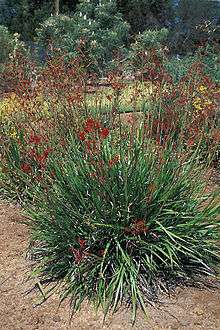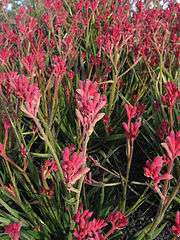Haemodoraceae
| Haemodoraceae | |
|---|---|
 | |
| Kangaroo Paw (Anigozanthos flavidus) | |
| Scientific classification | |
| Kingdom: | Plantae |
| (unranked): | Angiosperms |
| (unranked): | Monocots |
| (unranked): | Commelinids |
| Order: | Commelinales |
| Family: | Haemodoraceae R.Br.[1] |
| genera | |
|
The family has about 21 genera. | |
Haemodoraceae is a family of perennial herbaceous flowering plants with 14 genera and 102 known species.[2] It is sometimes known as the "Bloodwort family". Primarily a Southern Hemisphere family, they are found in South Africa, Australia and New Guinea, and in the Americas (from SE U.S.A. to tropical South America). Perhaps the best known are the widely cultivated and unusual Kangaroo Paws from Australia, of the two closely related genera Anigozanthos and Macropidia.
Taxonomy

The APG II system, of 2003 (unchanged from the APG system, of 1998), also recognizes this family and places it in the order Commelinales, in the clade commelinids, in the monocots. The family of the Haemodoraceae then includes about sixteen sub-tropical or tropical genera found in the southern hemisphere, two in North America and three known cultivated genera in Europe.[3]
Haemodoraceae is characterized by distichous leathery leaves, which are alternate, succulent, rather large and often ensiform, with entire margins and parallel veins.[4] The leaves are enclosed by a sheath with free margins and alternate, distichous (= in two vertical ranks).
The plants are hermaphroditic. Pollinators are primarily insects, but also birds or sometimes a small mammal. The wooly-haired flowers grow at the end of a leafles stalk, in cymes (with lateral branches), panicles or racemes.
Potentially confused plants
The term bloodwort can also apply to Sanguinaria canadensis (more often called bloodroot) or Achillea millefolium (more often called yarrow or common yarrow).
Genera
- Anigozanthos - Kangaroo Paws
- Barberetta
- Blancoa
- Conostylis
- Dilatris
- Haemodorum - Bloodroots
- Lachnanthes
- Macropidia - Black Kangaroo Paw
- Phlebocarya
- Pyrrorhiza
- Schiekia
- Tribonanthes
- Xiphidium
- Wachendorfia
References
- ↑ Angiosperm Phylogeny Group (2009). "An update of the Angiosperm Phylogeny Group classification for the orders and families of flowering plants: APG III" (PDF). Botanical Journal of the Linnean Society. 161 (2): 105–121. doi:10.1111/j.1095-8339.2009.00996.x. Retrieved 2013-06-26.
- ↑ Christenhusz, M. J. M.; Byng, J. W. (2016). "The number of known plants species in the world and its annual increase". Phytotaxa. Magnolia Press. 261 (3): 201–217. doi:10.11646/phytotaxa.261.3.1.
- ↑ Walters, Stuart Max (1986). The European Garden Flora: Pteridophyta, Gymnospermae, Angiospermae. Cambridge University Press. p. 290. ISBN 0-521-24859-0.
- ↑ Darlington, William (1853). Flora cestrica: an herborizing companion for the young botanists of Chester County...Pennsylvania. Philadelphia: Lindsay & Blakiston. p. 317. OCLC 4039950
External links
| Wikimedia Commons has media related to Haemodoraceae. |
- Haemodoraceae in L. Watson and M.J. Dallwitz (1992 onwards).
- The families of flowering plants Descriptions, illustrations, identification, information retrieval.
- Monocot families (USDA)
- NCBI Taxonomy Browser National Center for Biotechnology Information
- Haemodoraceae at CSDL
- overview of taxa in Western Australia (144 entries)